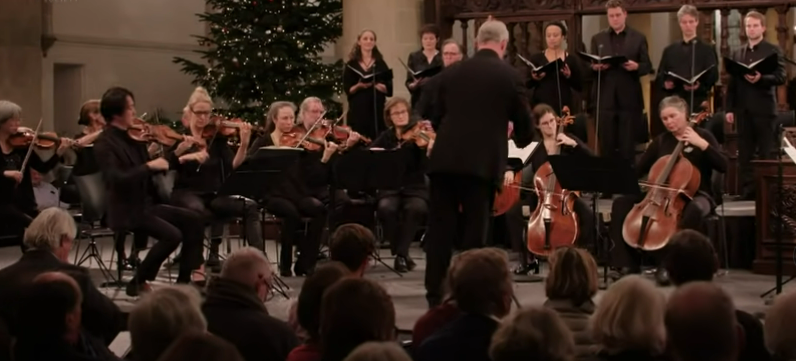11.4: Vocal Music in the Baroque- The Cantata
- Page ID
- 169698
Vocal Music in the Baroque Period (1600-1750)
You've already been exposed to some music in the Baroque Period, though most of it was instrumental music. The Baroque Period, which followed the Renaissance, marks beginning of the "Common Practice Era," as mentioned previously. You may have thought to yourself that vocal music from ancient Greece, the Middle Ages, and the Renaissance all sound "foreign" or "distant" to our modern ear. As was mentioned in previous chapters, that is because the music from these time periods---before the "Common Practice Era"---treated harmony, rhythm, melody, form, and texture very differently than modern music. Western music beginning in the Baroque Period began to treat musical elements more closely to that which resembles modern music.
Recall the last few pieces in this chapter: Machatu's "I can all too well compare my lady..." from the Middle Ages, and both "El grillo" and "Sing joyfully" from the Renaissance were all highly polyphonic. That is, they all employed multiple independent melodies simultaneously. You may have also realized that it was very difficult to latch onto the words at times, because so many different words were being sung at the same time. It's like going to a party where you hear 6 different conversations at the same time---it's hard to latch onto a single idea.
The Baroque Period sees the rise of homophonic texture, which was discussed back in Chapter 2.1. This texture is rooted in a single melody with simple accompaniment. The melody, which is purely independent, is supported by an instrumental accompaniment, which is purely dependent on the melody. Try listening to a simple accompaniment without a melody, and before long, you'll think to yourself "this is nice background music, but where's the melody?" That's because the accompaniment is not independent---it needs the melody (hence, its dependency on the melody). Homophonic texture is useful for composers especially those who write music with a sung text, because it's easy for the audience to understand the words clearly. As you would expect, the harpsichord and strings are among the most common instruments to accompany vocal music in the Baroque Period.
Baroque Music also contains many ornamentations; you'll hear many examples of these ornaments in the video presentation for this unit.
The Baroque Period also favored vocal music over instrumental music like the Medieval and Renaissance periods, but as mentioned before, the "rise of instrumental music" begins in the Baroque Period. That said, there are three common types of vocal music in the Baroque Period: the opera and the cantata. Because opera is attached to actual drama (with characters, staging, acting, etc.), we'll look at Baroque opera in the next unit. Here, we'll look at the cantata.
Cantata in the Baroque Period.

Netherlands Bach Society performs Bach's BWV 147. Screenshot taken from YouTube.
The word cantata is rooted in the word cantare, which is Latin for "sing." Thus, music titled cantatas are simply pieces that are sung. A cantata is a collection of several pieces of music written for solo singers, a choir, and an accompanying orchestra. Similar to the symphony, we have a different collection of "songs," which are also called "movements." Depending on who is singing, and how they are singing, we use different words to describe them. These types of vocal movements are also found in operas and oratorios, so the terms you see here will return in the following chapter on opera. Typically, there are 4 different types of movements in a cantata (and opera/oratorios):
Aria: very lyrical melody, for 1 or a few soloists with the accompanying orchestra. These have many melismata for the vocalist to shine. The word translates to "air," which makes sense because a lot of air is necessary to sing these long, lyrical, and melodious lines!
Recitative: the word translates to recite, as in to speak your lines (in a play). These are typically for 1 solo singer and the accompanying orchestra, and it sounds much more speaking and is much less "lyrical" than the aria.
Chorus/chorale: these are pieces for the full choir and orchestra.
Interlude: these are pieces that have no singers, and are purely for the orchestra.
Composer J.S. Bach, who you'll recognize from the previous chapters, wrote over 200 different cantatas, most of which contain at least 6 different movements. Some of his cantatas are sacred, and were meant to be performed within a church service, while other cantatas were completely secular. He even wrote one satirically comedic cantata nicknamed the "coffee cantata," where the solo singer discusses their addiction to coffee! Each of these cantatas is considered a single independent piece of music, even though they contain anywhere between 6-10 individual movements! A typical cantata can last between 20-30 minutes. For now, we'll look at a the chorale movement from Bach's church cantata BWV 147, which is one of his more popular surviving works titled "Jesu, joy of man's desiring. This popular melody is heard at many weddings and during Christmas season. Take a listen to this movement, and as you do, pay attention to the way that the orchestra and the chorus exchange musical phrases -- it's almost like a dialogue between singers and instruments. The music will also feel like it never stops --- this is a common trait of Baroque music. We call this the motor rhythm, and it refers to the fact that the music sounds like it never wants to end! When you're done listening, watch the video presentation for this section for a more in-depth discussion on the phrasing, harmonies, instrumentation, and rhythms within this movement.

